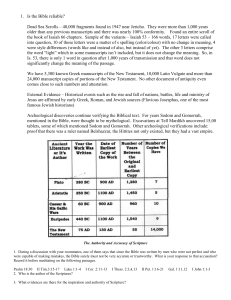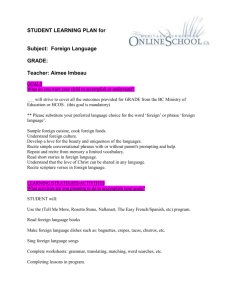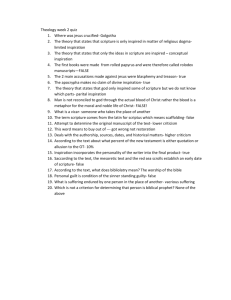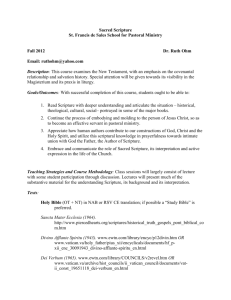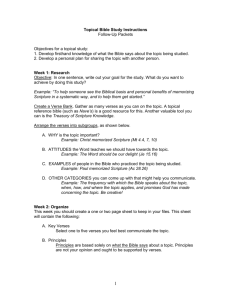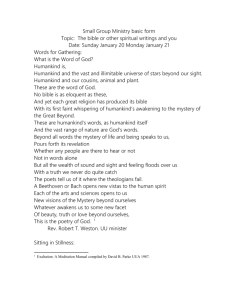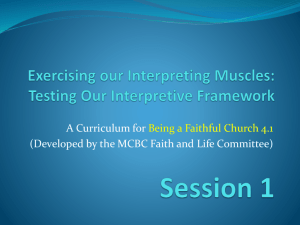Principles for Leading Bible Studies Using Imagination
advertisement
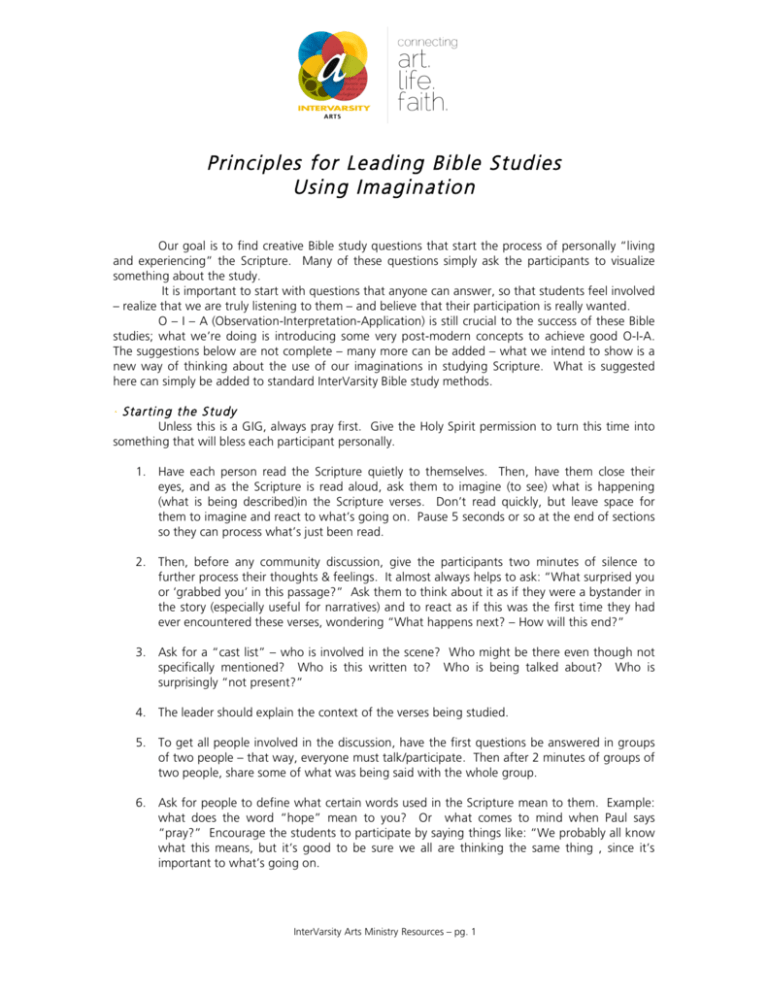
Principles for Leading Bible Studies Using Imagination Our goal is to find creative Bible study questions that start the process of personally “living and experiencing” the Scripture. Many of these questions simply ask the participants to visualize something about the study. It is important to start with questions that anyone can answer, so that students feel involved – realize that we are truly listening to them – and believe that their participation is really wanted. O – I – A (Observation-Interpretation-Application) is still crucial to the success of these Bible studies; what we’re doing is introducing some very post-modern concepts to achieve good O-I-A. The suggestions below are not complete – many more can be added – what we intend to show is a new way of thinking about the use of our imaginations in studying Scripture. What is suggested here can simply be added to standard InterVarsity Bible study methods. · Star ting t he S tudy Unless this is a GIG, always pray first. Give the Holy Spirit permission to turn this time into something that will bless each participant personally. 1. Have each person read the Scripture quietly to themselves. Then, have them close their eyes, and as the Scripture is read aloud, ask them to imagine (to see) what is happening (what is being described)in the Scripture verses. Don’t read quickly, but leave space for them to imagine and react to what’s going on. Pause 5 seconds or so at the end of sections so they can process what’s just been read. 2. Then, before any community discussion, give the participants two minutes of silence to further process their thoughts & feelings. It almost always helps to ask: “What surprised you or ‘grabbed you’ in this passage?” Ask them to think about it as if they were a bystander in the story (especially useful for narratives) and to react as if this was the first time they had ever encountered these verses, wondering “What happens next? – How will this end?” 3. Ask for a “cast list” – who is involved in the scene? Who might be there even though not specifically mentioned? Who is this written to? Who is being talked about? Who is surprisingly “not present?” 4. The leader should explain the context of the verses being studied. 5. To get all people involved in the discussion, have the first questions be answered in groups of two people – that way, everyone must talk/participate. Then after 2 minutes of groups of two people, share some of what was being said with the whole group. 6. Ask for people to define what certain words used in the Scripture mean to them. Example: what does the word “hope” mean to you? Or what comes to mind when Paul says “pray?” Encourage the students to participate by saying things like: “We probably all know what this means, but it’s good to be sure we all are thinking the same thing , since it’s important to what’s going on. InterVarsity Arts Ministry Resources – pg. 1 · Dee per Questions: Going from Observation to Interpretation to Application 1. Especially if it’s a story, ask for the participants’ imagination to fill in details not specifically given in the Scripture. Assure them that God give us imagination (Note: “In His Image” from Genesis and that “image (picture) is the root of the word) and that He can protect us as we use our imagination – that’s part of why we pray at the beginning of the study. This is a very important step for visualization and experiential learning. Example: “How old do you think the girl is?” (if we’re not given an exact age in the text.) or “What do you think the characters were wearing?” or “What do you think it might have felt like being there when this was happening?” 2. Ask about motivation. “What do you think that the Pharisees wanted to do?” or “Why did David say what he did?” or “What do you think Jesus was doing when He drew in the sand with His finger?” Note: each participant might have a different answer – and this is O.K. If someone imagines an answer that contradicts other Scripture, then the leader can clarify the issue and move ahead. 3. Ask: “If you were there when this first happened, who would you be?” “Who do you identify with in the Scripture?” Note: I often identify with several characters. 4. If you could write your own outcome to the end of the Scripture, what would it be? Example: “What would you have the ‘Prodigal Father’ say to his returning son?” 5. Interpretation questions should be asked. “What would be the reactions of the world 2000 years ago that differ from today’s 21st Century?” · Concludi ng the St udy: Application 1. Ask the participants to react to the Scripture on a personal level. Give them 10 minutes by themselves and encourage them to journal or to draw or to write something (a poem perhaps) that expresses something about their reaction to the Scripture being studied. It might be good to play some quiet non-vocal music. Some students are verbal processors, so it’s good to let them go into a corner and talk quietly. 2. During this quiet time, ask them to think about: a) what is a single word or short phrase that summarizes for you what we’ve been studying? b) What have you learned about God and His character? And c) What have you learned about yourself from this Scripture? 3. Sometimes it is very effective for the student to choose a single word (or a short phrase) that has impacted them deeply during the study, and to write that word on an 8X11 sheet of paper. Then, after praying about that word, decorate that word in any way that seems appropriate. Expand the size of the word and add colors to it – or journal beside the word – or copy other Scripture that comes to mind. This is a form of personal meditation that can be shared with others or kept private. 4. For those who choose, share what’s happening. Then pray as a whole group or groups of twos that God would bless our hearts and minds deeply with what we have been studying. 5. As the study ends, you might ask about what participants will seek to change in their daily lives as a result of the study. InterVarsity Arts Ministry Resources – pg. 2 Principles for Leading Bible Studies Using Imagination SCRIPTURE REFERENCES JOHN 7: 53 -8: 1 1 Then each went to his own home. (1) But Jesus went to the Mount of Olives. (2) At dawn He appeared again in the temple courts, where all the people gathered around Him, and He sat down to teach them. (3) The teachers of the law and the Pharisees brought in a woman caught in adultery. They made her stand before the group (4) and said to Jesus, “Teacher, this woman was caught in the act of adultery. (5) In the law Moses commanded us to stone such women. Now what do you say?” (6) They were using this question as a trap, in order to have a basis for accusing him. But Jesus bent down and started to write on the ground with His finger. (7) When they kept on questioning Him, He straightened up and said to them, “If any one of you is without sin, let him be the first to throw a stone at her.” (8) Again He stooped down and wrote on the ground. (9) At this, those who heard began to go away one at a time, the older ones first, until only Jesus was left, with the woman still standing there. (10) Jesus straightened up and asked her, “Woman, where are they? Has no one condemned you?” (11) “No one, sir,” she said. “Then neither do I condemn you,” Jesus declared. “Go now and leave your life of sin.” PHILIPPIANS 4:6 -7 Do not be anxious about everything, but in everything, by prayer and petition, with thanksgiving, present your requests to God. (7)And the peace of God, which transcends all understanding, will guard your hearts and your minds in Christ Jesus. InterVarsity Arts Ministry Resources – pg. 3

